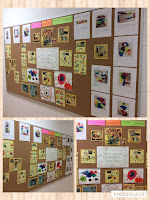As educators it is our job to make the learning visible for the ones who were not there to be able to see happening live. They are many ways for educators to re tell the learning process through different types of observation and documentation strategies.
- Pictures
- Learning Collages
- Videos
- Portfolios
- Bulletin/ Parent Boards
- Written Observation
- Children’s Work
Our curriculum is based on the children and the children’s interests. We plan play & inquiry-based learning opportunities, as well as provocation invitations based on what we have observed from the children. To be able to plan activities and provocations we need to use observation to see how the children are using different materials and how they are engaging in play to be able to capture their interests. Observing doesn't mean standing over the children with a clipboard forcing them to play but it means to join into their play or to watch from a distance. When the children do not know they being are watched, they truly put all their imagination into their play. When the children also feel comfortable with you as the educator, joining into their play, they will start expand on the story being told. This will leave you with hints and clues as to what the children are interested in.
Why do we need to observe children and document what we see?
When we make the learning visible we also give the children a chance to go back and reflect on their own learning. The educators aren't the only ones who have to capture every learning moment that takes place in the classroom. By providing children with an iPad it gives them a chance to capture their own learning and they are able to go back and reflect on what they have created. When we allow the children to capture their own learning they are able to capture every moment of the process but when they have to wait for an educator something could happen to their learning and they might lose the chance to be able to reflect on the process.
When we make the learning visible we also give the children a chance to go back and reflect on their own learning. The educators aren't the only ones who have to capture every learning moment that takes place in the classroom. By providing children with an iPad it gives them a chance to capture their own learning and they are able to go back and reflect on what they have created. When we allow the children to capture their own learning they are able to capture every moment of the process but when they have to wait for an educator something could happen to their learning and they might lose the chance to be able to reflect on the process.
Being able to observe a child truly explore and inquire on a certain interest they might come across on their own time is meaningful to not only the child but for the educators too. What if you miss this amazing wonder the child had? How would you be able to expand on their learning if you don't know what they have been thinking about? Observing the children and documenting their play will help you catch their interest. The hard part is how do you observe 20-30 children at a time if there are only one or two of us? Including the children in their own documentation will make documentation easier. Documentation is tool to help you capture children’s learning from the start of the year as well as the process over the span of the year. Documenting is a tool that we as educators use everyday to ensure we continue documenting the work that the children do over the course of the year.
We observe to capture the meaningful learning that happens around the classroom and make sure we always have a chance for the children to revisit their own learning at any point of the year if they choose to do so.




No comments:
Post a Comment